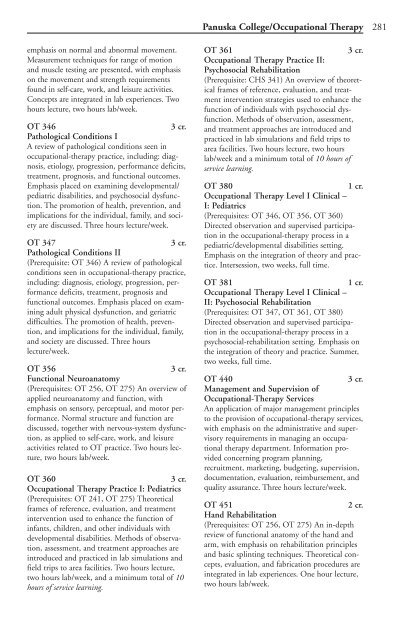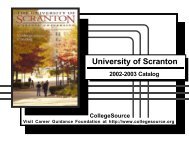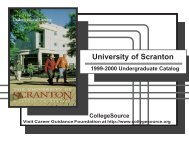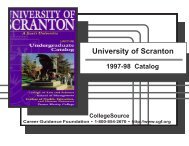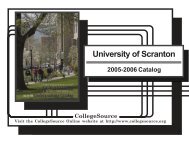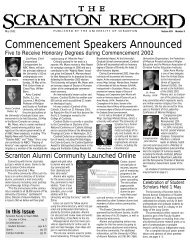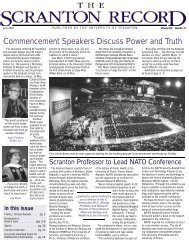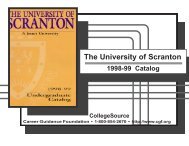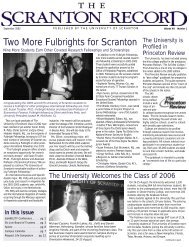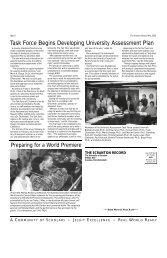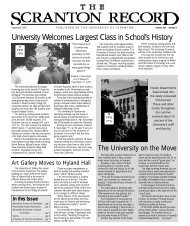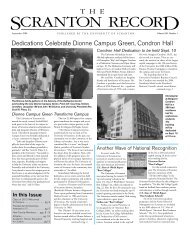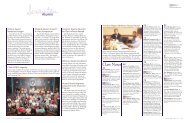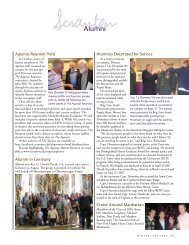2003-2004 - The University of Scranton
2003-2004 - The University of Scranton
2003-2004 - The University of Scranton
Create successful ePaper yourself
Turn your PDF publications into a flip-book with our unique Google optimized e-Paper software.
emphasis on normal and abnormal movement.<br />
Measurement techniques for range <strong>of</strong> motion<br />
and muscle testing are presented, with emphasis<br />
on the movement and strength requirements<br />
found in self-care, work, and leisure activities.<br />
Concepts are integrated in lab experiences. Two<br />
hours lecture, two hours lab/week.<br />
OT 346 3 cr.<br />
Pathological Conditions I<br />
A review <strong>of</strong> pathological conditions seen in<br />
occupational-therapy practice, including: diagnosis,<br />
etiology, progression, performance deficits,<br />
treatment, prognosis, and functional outcomes.<br />
Emphasis placed on examining developmental/<br />
pediatric disabilities, and psychosocial dysfunction.<br />
<strong>The</strong> promotion <strong>of</strong> health, prevention, and<br />
implications for the individual, family, and society<br />
are discussed. Three hours lecture/week.<br />
OT 347 3 cr.<br />
Pathological Conditions II<br />
(Prerequisite: OT 346) A review <strong>of</strong> pathological<br />
conditions seen in occupational-therapy practice,<br />
including: diagnosis, etiology, progression, performance<br />
deficits, treatment, prognosis and<br />
functional outcomes. Emphasis placed on examining<br />
adult physical dysfunction, and geriatric<br />
difficulties. <strong>The</strong> promotion <strong>of</strong> health, prevention,<br />
and implications for the individual, family,<br />
and society are discussed. Three hours<br />
lecture/week.<br />
OT 356 3 cr.<br />
Functional Neuroanatomy<br />
(Prerequisites: OT 256, OT 275) An overview <strong>of</strong><br />
applied neuroanatomy and function, with<br />
emphasis on sensory, perceptual, and motor performance.<br />
Normal structure and function are<br />
discussed, together with nervous-system dysfunction,<br />
as applied to self-care, work, and leisure<br />
activities related to OT practice. Two hours lecture,<br />
two hours lab/week.<br />
OT 360 3 cr.<br />
Occupational <strong>The</strong>rapy Practice I: Pediatrics<br />
(Prerequisites: OT 241, OT 275) <strong>The</strong>oretical<br />
frames <strong>of</strong> reference, evaluation, and treatment<br />
intervention used to enhance the function <strong>of</strong><br />
infants, children, and other individuals with<br />
developmental disabilities. Methods <strong>of</strong> observation,<br />
assessment, and treatment approaches are<br />
introduced and practiced in lab simulations and<br />
field trips to area facilities. Two hours lecture,<br />
two hours lab/week, and a minimum total <strong>of</strong> 10<br />
hours <strong>of</strong> service learning.<br />
Panuska College/Occupational <strong>The</strong>rapy 281<br />
OT 361 3 cr.<br />
Occupational <strong>The</strong>rapy Practice II:<br />
Psychosocial Rehabilitation<br />
(Prerequisite: CHS 341) An overview <strong>of</strong> theoretical<br />
frames <strong>of</strong> reference, evaluation, and treatment<br />
intervention strategies used to enhance the<br />
function <strong>of</strong> individuals with psychosocial dysfunction.<br />
Methods <strong>of</strong> observation, assessment,<br />
and treatment approaches are introduced and<br />
practiced in lab simulations and field trips to<br />
area facilities. Two hours lecture, two hours<br />
lab/week and a minimum total <strong>of</strong> 10 hours <strong>of</strong><br />
service learning.<br />
OT 380 1 cr.<br />
Occupational <strong>The</strong>rapy Level I Clinical –<br />
I: Pediatrics<br />
(Prerequisites: OT 346, OT 356, OT 360)<br />
Directed observation and supervised participation<br />
in the occupational-therapy process in a<br />
pediatric/developmental disabilities setting.<br />
Emphasis on the integration <strong>of</strong> theory and practice.<br />
Intersession, two weeks, full time.<br />
OT 381 1 cr.<br />
Occupational <strong>The</strong>rapy Level I Clinical –<br />
II: Psychosocial Rehabilitation<br />
(Prerequisites: OT 347, OT 361, OT 380)<br />
Directed observation and supervised participation<br />
in the occupational-therapy process in a<br />
psychosocial-rehabilitation setting. Emphasis on<br />
the integration <strong>of</strong> theory and practice. Summer,<br />
two weeks, full time.<br />
OT 440 3 cr.<br />
Management and Supervision <strong>of</strong><br />
Occupational-<strong>The</strong>rapy Services<br />
An application <strong>of</strong> major management principles<br />
to the provision <strong>of</strong> occupational-therapy services,<br />
with emphasis on the administrative and supervisory<br />
requirements in managing an occupational<br />
therapy department. Information provided<br />
concerning program planning,<br />
recruitment, marketing, budgeting, supervision,<br />
documentation, evaluation, reimbursement, and<br />
quality assurance. Three hours lecture/week.<br />
OT 451 2 cr.<br />
Hand Rehabilitation<br />
(Prerequisites: OT 256, OT 275) An in-depth<br />
review <strong>of</strong> functional anatomy <strong>of</strong> the hand and<br />
arm, with emphasis on rehabilitation principles<br />
and basic splinting techniques. <strong>The</strong>oretical concepts,<br />
evaluation, and fabrication procedures are<br />
integrated in lab experiences. One hour lecture,<br />
two hours lab/week.


